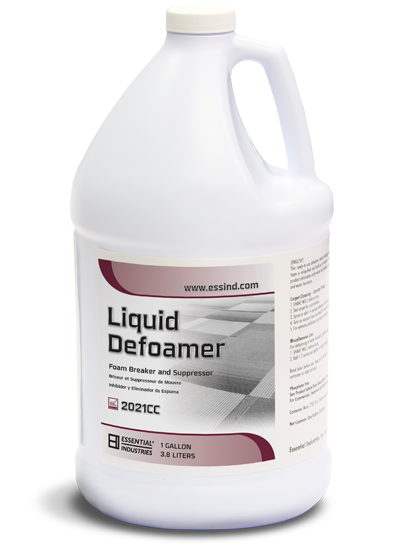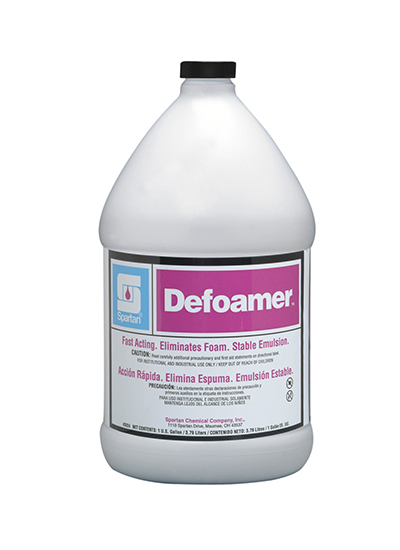What Makes Chemical Defoamer Necessary for Handling Foam Build-Up
What Makes Chemical Defoamer Necessary for Handling Foam Build-Up
Blog Article
Checking Out the Perks of a Chemical Defoamer in Manufacturing and Manufacturing
The integration of chemical defoamers in manufacturing and production procedures supplies a tactical advantage by attending to one of the relentless challenges in industrial operations: foam control. As makers make every effort to maximize processes and enhance customer fulfillment, the function of chemical defoamers comes to be significantly essential.
Importance of Foam Control
While the presence of foam in manufacturing processes can in some cases seem harmless, efficient foam control is critical for maximizing operational performance and item quality. Foam can hinder various stages of production, resulting in ineffectiveness that may extend and increase costs handling times. In sectors such as food and drink, drugs, and chemicals, uncontrolled foam can obstruct equipment, disrupt automated systems, and inevitably cause item variances.

Implementing effective foam control techniques not just boosts performance but also supports regulative conformity in sectors where foam can bring about ecological concerns. By utilizing chemical defoamers, producers can alleviate these difficulties, making certain smoother procedures and higher-quality final result. Inevitably, prioritizing foam control is an important element of manufacturing that can produce considerable benefits in terms of security, effectiveness, and product dependability.
Kinds Of Chemical Defoamers
What kinds of chemical defoamers are offered for manufacturing processes, and exactly how do they differ in application? Chemical defoamers can be categorized into 3 major kinds: silicone-based, organic, and inorganic defoamers. - Chemical Defoamer

Organic defoamers, commonly stemmed from fatty acids or natural oils, work in a series of applications, including food and beverage manufacturing. They are frequently favored for their reduced toxicity and environmental effect, making certain compliance with market guidelines.

Each kind of defoamer serves distinct objectives based upon the chemical composition and the specific requirements of the manufacturing procedure, enabling makers to choose one of the most appropriate option for their certain needs.

Advantages in Manufacturing Performance
Chemical defoamers play an important duty in improving making effectiveness by effectively managing foam generation throughout different procedures. Foam can hinder manufacturing prices, interrupt tools operation, and cause costly downtime. By integrating chemical defoamers, manufacturers can alleviate these concerns, ensuring smoother process and raised general performance.
The use of chemical defoamers assists maximize the operational performance of devices such as pumps, mixers, and activators. With lowered foam, these machines can operate at their planned ability, reducing the danger of overflow and making it possible for consistent processing. This leads to much better source utilization and higher throughput.
Additionally, chemical defoamers promote faster processing times by decreasing the time required for foam elimination. This velocity can dramatically impact production routines, enabling makers to fulfill customer demand better. Additionally, using defoamers contributes to decrease energy consumption, as machinery operates much more effectively with decreased foam disturbance.
Effect on Item High Quality
Foam control is not just necessary for keeping performance in making procedures yet additionally plays a substantial duty in making certain item top quality. Extreme foam can introduce air into formulations, leading to inconsistencies in the final item. This can show up as issues such as gaps, unequal structures, or substandard surfaces, which undermine the intended top quality and efficiency of the item.
Additionally, foam can hinder the homogeneity of mixtures, causing irregular circulation of active ingredients. In sectors such as layers, cosmetics, and food check it out manufacturing, this can result in variations in shade, preference, and general effectiveness. By utilizing a chemical defoamer, producers can alleviate these threats, making certain that items satisfy strict top quality requirements.
Furthermore, controlling foam can boost the security of suspensions and solutions, which is important for guaranteeing shelf-life and consumer contentment. With enhanced product uniformity and reduced issues, makers can accomplish greater requirements of quality control, ultimately bring about enhanced consumer depend on and brand commitment.
Cost-Effectiveness and ROI
Reliable foam control not only boosts product top quality but additionally contributes dramatically to the overall cost-effectiveness of making processes. Using chemical defoamers minimizes foam-related problems, which can or else lead to manufacturing delays, tools malfunctions, and boosted power consumption. By lowering foam, producers can enhance their procedures, resulting in greater throughput and efficiency.
Buying chemical defoamers can produce a substantial roi (ROI) The first costs related to these ingredients are often balanced out by the financial savings realized from decreased downtime and enhanced product return. Boosted product quality can minimize waste and remodel prices, further bolstering monetary performance.
Additionally, reliable foam control can bring about reduced water and energy usage, adding to lower operational expenses. This is especially check it out vital in sectors where resource efficiency is critical. By integrating chemical defoamers into their processes, makers can accomplish long-lasting cost savings while preserving affordable prices in the market.
Final Thought
To conclude, the combination of chemical defoamers in manufacturing and production processes is important for optimizing operational efficiency and enhancing item top quality. Reliable foam control adds to enhanced devices performance, reduced processing times, and decreased downtime, inevitably bring about considerable expense savings. In addition, consistent product solutions foster consumer complete satisfaction and brand name loyalty. The advantages used by chemical defoamers not just sustain regulative conformity but likewise offer an one-upmanship in the production landscape.
The assimilation of chemical defoamers in manufacturing and production procedures provides a critical advantage by resolving one of the consistent challenges in commercial operations: foam control.While the visibility of check out here foam in producing procedures can in some cases appear harmless, reliable foam control is important for optimizing functional efficiency and item high quality.Chemical defoamers play a crucial function in enhancing producing performance by successfully controlling foam generation during numerous processes.Additionally, chemical defoamers facilitate faster handling times by lowering the time required for foam elimination. Additionally, the use of defoamers adds to lower energy intake, as machinery runs more effectively with reduced foam interference.
Report this page